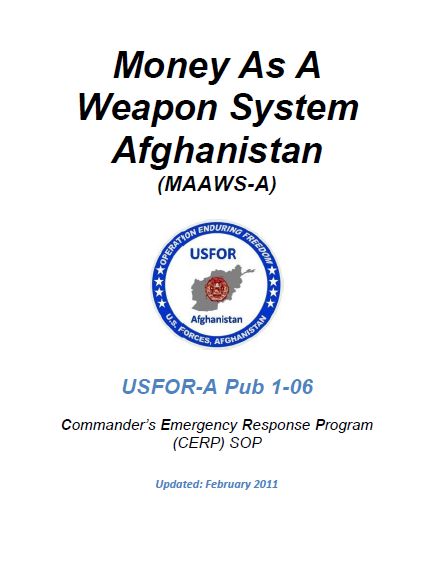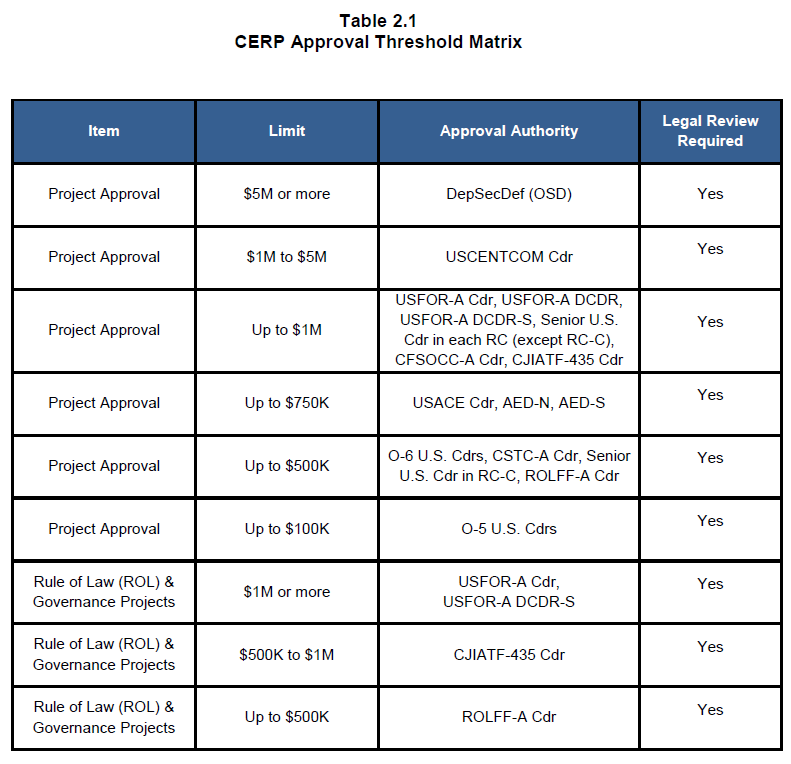Money As A Weapon System Afghanistan (MAAWS-A)
- Commander’s Emergency Response Program (CERP) SOP
- 239 pages
- February 2011
- 8 MB
AUTHORIZED USES OF CERP
A. The authorized uses of CERP are listed below. For more information on each category and examples within each category, reference Annex A.
1. Agriculture: Projects to increase agricultural production or cooperative agricultural programs. This category includes irrigation systems.
2. Battle Damage Repair: Projects to repair, or make payments for repairs, of property damage resulting from U.S., coalition, or supporting military operations and is not compensable under the Foreign Claims Act. See Annex A for more details.
3. Civic Cleanup Activities: Projects to cleanup public areas; area beautification.
4. Civic Support Vehicles: Projects to purchase or lease vehicles by public/government officials in support of civic and community activities.
5. Condolence Payments: Payments to individual civilians for the death or physical injury resulting from specific U.S., coalition, or supporting military operations not compensable under the Foreign Claims Act. See Annex A for more details.
6. Economic, Financial, and Management Improvements: Projects to improve economic or financial security.
7. Education: Projects to repair or reconstruct schools, or to purchase school supplies or equipment.
8. Electricity: Projects to repair, restore, or improve electrical production, distribution, and secondary distribution infrastructure. Cost analysis must be
conducted so the village or district may collect revenue to ensure operation and maintenance of the system for long-term use.
9. Food Production & Distribution: Projects to increase food production or distribution processes to further economic development.
10. Former Detainee Payments: Payments to individuals upon release from Coalition (non-Theater Internment) detention facilities. See Annex A for more details.
11. Healthcare: Projects to repair or improve infrastructure, equipment, medical supplies, immunizations, and training of individuals and facilities in respect to efforts made to maintain or restore health especially by trained and licensed professionals.
12. Hero Payments: Payments made to the surviving spouses or next of kin of Afghan defense or police personnel who were killed as a result of U.S., coalition, or supporting military operations. Projects to repair collateral damage not otherwise payable because of combat exclusions or condolence payments. See Annex A for more details.
13. Other Urgent Humanitarian or Reconstruction Projects: Projects to repair collateral damage not otherwise payable because of combat exclusions or condolence payments. Other urgent humanitarian projects not captured under any other category. Only use this category when no other category is applicable. This authority cannot be used when the requested item is otherwise prohibited by the SOP or DoD FMR.
14. Protective Measures: Projects to repair or improve protective measures to enhance the durability and survivability of a critical infrastructure site.
15. Repair of Civic & Cultural Facilities: Projects to repair or restore civic or cultural buildings or facilities.
16. Rule of Law & Governance: Projects to repair government buildings such as administrative offices or court houses. Projects to restore pre-existing Rule of Law (ROL) facilities; with these types of projects, the Commander must verify the community receiving the facility did in fact have ROL operations ongoing in their community. For example, if a community did not operate a court house, a jail, or an administration office, the use of CERP is inappropriate to create that infrastructure. But, where a community was or is executing governmental operations, CERP projects are appropriate to increase capability to those operations.
17. Telecommunications: Projects to repair or extend communication over a distance. The term telecommunication covers all forms of distance and/or conversion of the original communications, including radio, telegraphy, television, telephony, data communication, and computer networking. Includes projects to repair or reconstruct telecommunications systems or infrastructure.
18. Temporary Contract Guards for Critical Infrastructure: Projects to guard critical infrastructure, neighborhoods and other public areas.
19. Transportation: Projects to repair or restore transportation to include infrastructure and operations. Infrastructure includes the transport networks (roads, railways, airways, canals, pipelines, etc.) that are used, as well as the nodes or terminals (such as airports, railway stations, bus stations, and seaports). These operations deal with the control of the system, such as traffic signals and ramp meters, railroad switches, air traffic control, etc.
20. Water & Sanitation: Projects to repair or improve drinking water availability, to include purification and distribution. Building wells in adequate places is a way to produce more water, assuming the aquifers can supply an adequate flow. Other water sources such as rainwater and river or lake water must be purified for human consumption. The processes include filtering, boiling, distillation among more advanced techniques, such as reverse osmosis. The distribution of drinking water is done through municipal water systems or as bottled water. Sanitation, an important public health measure that is essential for the prevention of disease, is the hygienic disposal or recycling of waste materials, particularly human excrement.…


